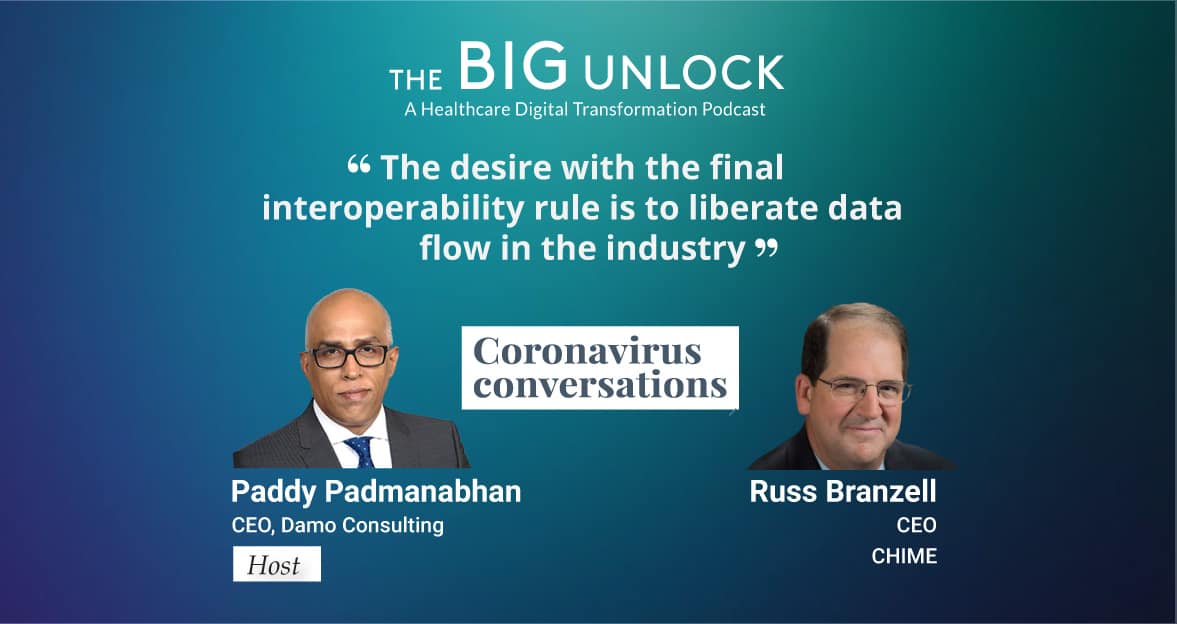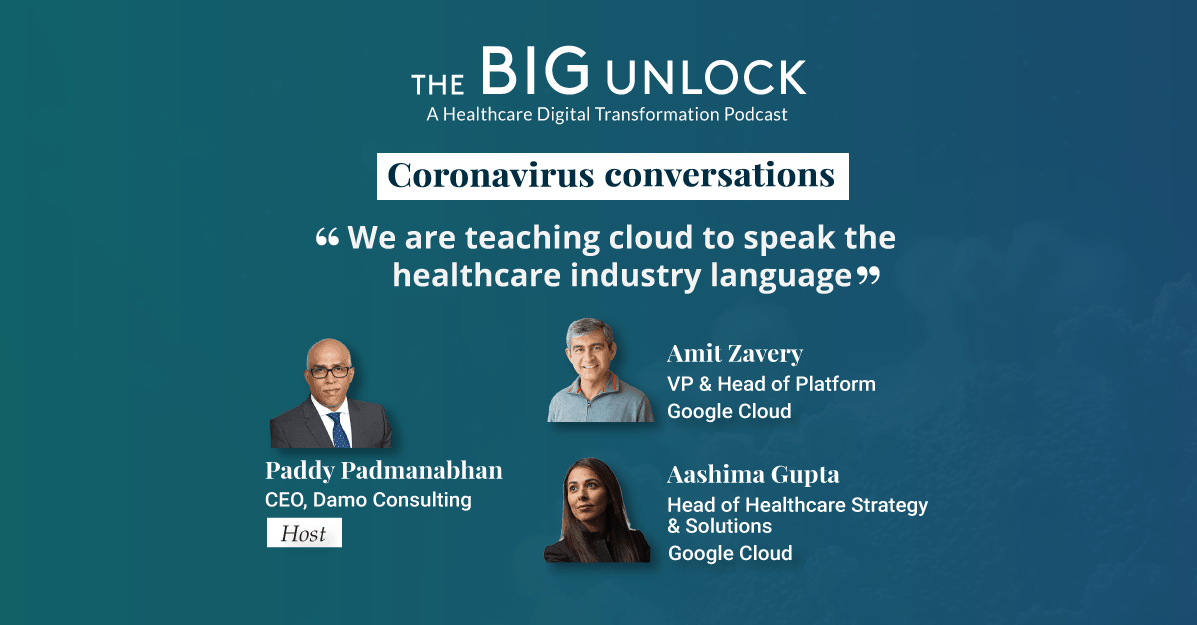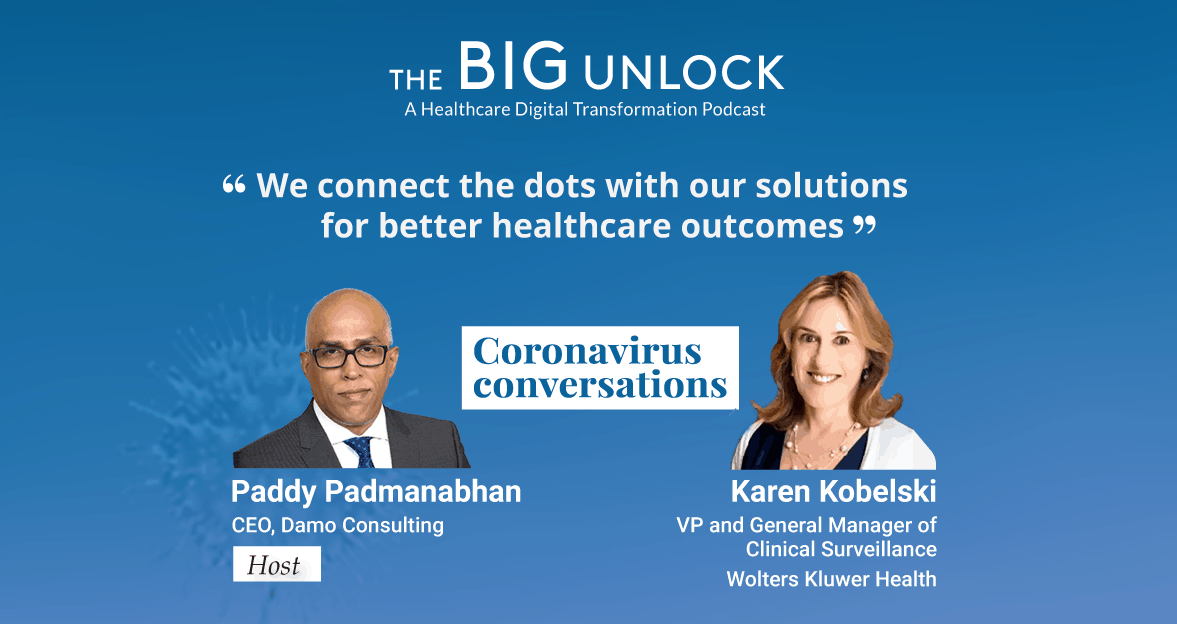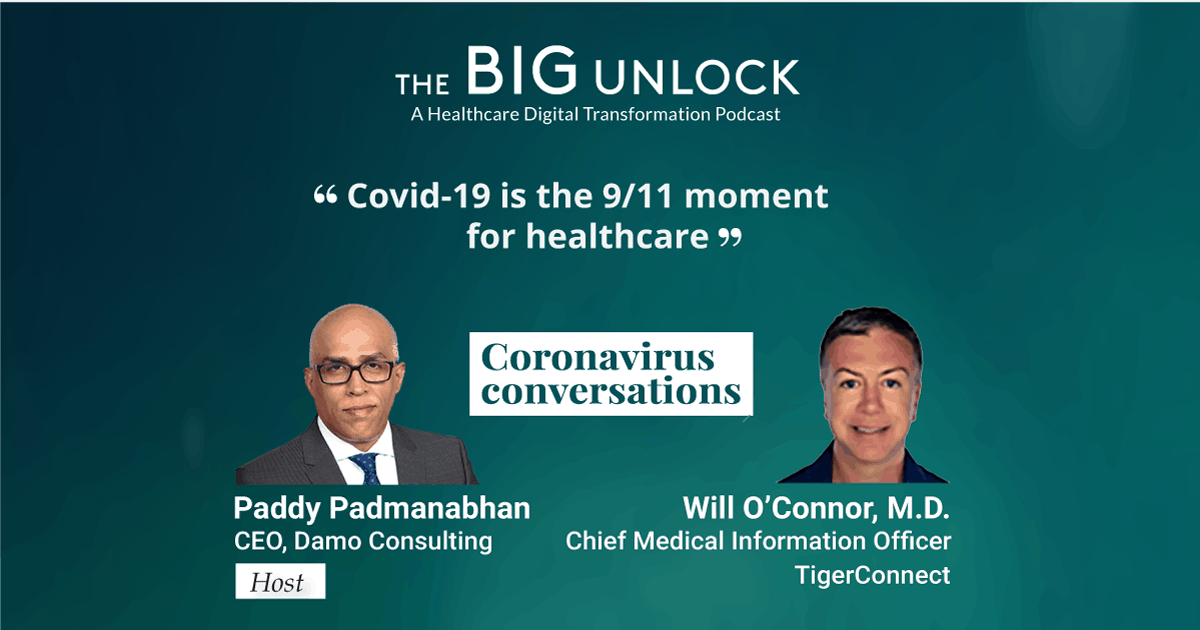Coronavirus conversations
Coronavirus conversations
Russ Branzell, CEO, CHIME
"The desire with the final interoperability rule is to liberate data flow in the industry"
 Hosted by Paddy Padmanabhan
Hosted by Paddy Padmanabhan 
Share
In this episode, Russ Branzell, CEO of CHIME discusses their role in the healthcare industry and how COVID-19 will impact health systems. Russ also shares his thoughts about the final interoperability rule and FCC telehealth investment program.
CHIME supports its members in their transformation and growth journey by assisting them in their professional development and be the best leaders in the healthcare industry. Russ states that we may see mergers and acquisitions accelerate in the industry due to the current pandemic. He also believes that the technology impact due to the COVID-19 crisis, whether intended or unintended, will accelerate digital activities in health systems.
This is also a video podcast.
Russ Branzell, CEO of CHIME in conversation with Paddy Padmanabhan, CEO of Damo Consulting on the Big Unlock Podcast – “The desire with the final interoperability rule is to liberate data flow in the industry”
PP: Welcome back to my podcast and it is my great privilege to introduce my very special guest and friend, Russ Branzell, CEO of CHIME. Thank you so much for taking the time to be with us today. Please tell us a little bit about what CHIME is and what CHIME does?
RB: CHIME or the College of Healthcare Information Management Executives, is a professional association for healthcare IT executives, could be CIOs, which has been our history. We also have CMIO’s in the organization, CNIO’s, Chief Innovation now, and a bunch of other titles. As the industry continues to grow and mature positions, our role is simple that is to support our members, both our CHIME members and our CHIME Foundation, which are our vendor partners in their transformation, in their growth to support the industry. We are not a trade show organization, we don’t run Expos. Our whole role is to pour into these folks, support them in Washington, support them in the professional development, help them be the best leaders. Maybe what has been pointed out even most recently, a little bit of a broken system around. So, CHIME has seen some significant growth recently over the last few years. We are now in 57 countries around the world. We have eleven independent operating groups or chapters in other countries. And the domestic growth here in the United States has not only grown significantly in the CIO ranks and other CHIME members, but we’ve also launched three other professional associations for Chief Technology, Chief Application and Chief Information Security Officers and those have seen substantial growth. All of these roles are heading a pretty high peak of maturity in their organizations and as we can see recently, both for negative reasons but also positive outcomes, has never been more important than it is right now with what we’re fighting.
PP: I am proud to say that my firm Damo Consulting is also a foundation partner with CHIME, and we have benefited greatly from the partnership. And I want to thank you and your team for all the wonderful work that you continue to do.
RB: Thank you. It is an honor to have you in the organization, but most importantly, serving alongside of us as we try to take on tough stuff.
PP: How the pandemic has impacted CHIME and what changes you had to make in the recent past.
RB: We did not get to have our face to face meeting this spring that is held prior to the HIMSS annual conference, which for all our members that normally attend that. That is always a good time for us. It is a time for us to refresh relationships, build new networks. And that was difficult for us. Now, the converse of that side has been what I would construe as a significant positive. And that is the emerging technologies that are already out there that have gone from probably infancy to at least early adulthood in a matter of light-years. Whether it is what we are on now, Zoom or any of these other technologies that are out there. We havespent more quality time with people. One, we are constrained to home, so we are making a different effort and a different focus than traveling around the globe. We were able to spend some quality time with people, hear what is going on, find out new ways to support them. And that has driven us not that our technology and our strategy wasn’t already taking us there, but we were already heading in a digital path. And the digital path that we are on really was to support the entire globe from a digital platform perspective. Like many of our members, regardlessit is foundation firms or CHIME members and things that were planned for maybe months, even years have gotten done in weeks and days. We have now completely changed to a digital environment that will also complement in-person meetings in the future when things normalize out. That is probably the biggest change. But as you probably expect, the biggest impact has been there’s so much coming out of Washington right now and states, but mostly Washington, that we’re spending in an extremely large amount of time ciphering through all the different information, getting member alerts out. The perfect example is today when the alert that went out yesterday from the government, immediately they changed the timing within 24 hours of sending out. They immediately changed the timing again.
PP: We’ll come back to Washington, D.C. on the work that CHIME doing on behalf of all the members. From your point of view as a CEO of CHIME you get to see a broad cross-section of health systems across the country and you probably have visibility from a first-hand perspective as to what is really going on. And we are beginning to see some early signs of some distress that health systems are going through. Financially speaking, we saw HCA announce their results earlier this week and they indicated that their results were not favorable, primarily because of all the non-elective procedures that have kind of dropped in volumes. But that’s just one data point. I am curious to know what you are seeing and hearing as it relates to how the pandemic is going to impact health systems in the near-term. What should we expect?
RB: Everyone’s taken a big hit on this, whether it’s the U.S. or actually globally in different forms of economic models in hospitals or health systems around the globe. The U.S. model, which very much is revenue-based, is probably taken at the most significant hits on this. I’ve talked to people, not every state wants to say a significant number of them,and the themes are the same. Significant decreases in outpatient and acute procedures and or admissions. And that just has a significant effect on the bottom line, which means they are going to have to make hard decisions or are making hard decisions right now. And I think it is going to come in. This is going to come in two significant waves. One; short term weathering what they’re doing to just make sure they can still meet the mission requirements and then the long-term impact of that as well. Well, a lot of that will be told by time and how big of an impact, some organizations are going to be well, if they’ve got deep cash on hands and they can weather this out. They’ve built digital strategies that probably help them somewhat through this, maybe a little more proactively than others. But there’s definitely some that this will be a substantial, substantial long-term multi-year hit to recover from. And they’ll have to figure out how and what they do to invest, to recover from that.
PP: The government announced a stimulus package and a second one is going through and there was a significant amount of the money set aside for hospitals. I believe it was a hundred billion in the first round. Is that making a significant impact or is it just a drop in the bucket in the grand scheme of things?
RB: Anything that comes in at this point is going to help. I mean, especially whether it is the PPP program for smaller organizations or significant cash flow increase or infusion from this government, stimulus funds are going to help. Can’t infer that they won’t, but it is significantly less. I was spending time with some of the leadership of some of the other large associations that you can imagine what their advocacy work has been doing in Washington, D.C. And one of the numbers that one of the CEOs threw out was to make the kind of impact to normalize this out. We are probably talking north of a trillion dollars. So, if 100 billion was infused, that means we are probably missing this by about 90 percent. And again, I have talked to some CIOs representing their organizations that said whether it’s going to hurt. I have heard some say that they’re worried about what this looks like long term. I know there was a second-round that’s trying to be worked on right now for some organizations, but definitely it’s the right direction. But when you tell every health system in the country, turn off your elective procedures, turn off the things that generally drive the engine, even if you don’t have COVID patients in, which was probably the right thing to do initially. It does have a dramatic negative effect.
PP: You mentioned, digital transformation and at CHIME you have undergone a bit of a digital transformation yourself in response to the crisis. My organization has been a virtual company forever. And we really didn’t feel any impact. We just transitioned very smoothly from our normal way of working to the current way of working with the only exception being that I don’t travel anymore. I have not traveled for a while. I remember my last travel date was the 6th of March. And in hindsight, maybe I should not have traveled on the 6th of March, but that’s a whole separate story. John Kravitz, CHIME CHAIR, and CIO of Geisinger was on my podcast and he talked about digital transformation. And it was interesting what he said to me was that his priorities in the near-term have definitely been influenced by the response effort to the pandemic. But that doesn’t mean they’re slowing down on digital transformation because that is what is going to position the organization for the future. What are you hearing with regards to the balancing of the near-term emergency-related response and what is important and essential for the longer-term survival and sustenance of the organization? What are you seeing across the board?
RB: I think there definitely is a percentage of organizations you could probably divide this into thirds. And that’s, again, way overgeneralizing. There is probably a third of organizations that are very similar to John’s and obviously I am very close to John, I have spent a lot of time with them being my boss. But I know the organization well. Also, that are really these organizations that have been focused on digital transformation. And again, I do not want to say unfortunate because it is fortunate for us. Organizations like that can flex and move because they live a world of digital transformation already. And this is really forced what we were projecting three to five years based on a normal adoption curve to get to some of the places, the differences we did in three to five weeks. Some organizations like Johns were able to do that a little more seamlessly, maybe a better way to put that is a little less difficult. Some organizations were able to do it and it was painful. And there’s still some organizations are really struggling with that. I think John is a great example of this is a symbiotic relationship. Their digital strategy is its strategy moving forward. And even today so it fits part and parcel to their reaction to this from a COVID as well. So, it’s not different. It’s just now an adaptation to an existing strategy. Some organizations, this is really shined a light on what they were thinking of doing. Now they have done it in three to five weeks. Now they are going to put some really good wrappers around this, figure out how to really thrive in this environment over the next few years. But it is relatively new for those that were not even on their radar. They’re going to struggle for a little while, but maybe we’ll get help from people like you and others out there that can help them in this journey. But there’s definitely some out there, especially some of our smaller areas that don’t have the infrastructure, the support, telemedicine and the other things that this will be a bit of a journey for them and they may return to back a little bit more of an old school mentality.
PP: Are we going to see some hospitals not make it to put it in a somewhat Darwinistic way that it’s going to be the survival of the digital fittest? And some are just not going to make it and we are going to have to be prepared for that.
RB: Yeah, in order for it to normal numbers that have come out from the AHA in years past. There are hospitals that no matter what, even if this didn’t occur. There are hospitals that are going to merge with others may be closed. There were some reported even last year, there were just closing because of their financial model, their local area was decreasing in population. There’s just that normal process that goes on in any large ecosystem like healthcare. I think this may accelerate it for some as they struggle, or financial issues may happen. It may accelerate for the short term, maybe for the long term. But I think for at least the short term, you may see mergers and acquisitions accelerate, especially with those with the cash ability to help others out. And it is a good fit, but right out of the gate, we are just going to see hospitals close. I hope communities do not allow that to occur because they are such a vital asset. But in some places, maybe when there is there may be outside of COVID, maybe over bedded and too much competition, you may see some. And that may not be a bad thing. It may be a horrible thing. It just depends on the situation in each community.
PP: Well, one thing is for sure, it seems like we are going to see some structural changes in the entire healthcare ecosystem. In terms of the technology, people have gone overnight to adopting telehealth as a default mode of operation.And that, among other things, puts a lot of pressure on the vendors, the technology vendors to make sure that the technology holds. What are you hearing when it comes to this? You mentioned Zoom. Zoom went from 10 million subscribers or 200 million. And we all know that Zoom has had some issues as well. What you’re hearing about how the telehealth technologies are holding up?
RB: I have been able to talk to some senior leaders, specifically CEOs of some of the telemedicine companies. And it is interesting to hear their numbers when they talk about their entire 2019 volume increase was 20 percent. And they were thrilled with that because they beat their budget estimates. In the first week of this, it went up 700 percent and then the next week it went up a thousand percent. And they said at some point we just stopped counting because a straight-up curve is not a curve. It is just a line. And most of them said they are handling it well. The biggest issue that they are seeing is the lack of technology support from the back-endpoint technology support. I would use the word maturity on the back-end support, home broadband issues. No one was expecting. I will pick on John. No one’s expecting eighteen hundred physicians in rural Pennsylvania live everywhere all of a sudden over a weekend to have to go home and have high-quality digital internet access at home to be able to do telemedicine, that there’s just going to be some latency issues to getting that all up to the speed it should be. It does point out also that the rural issues that we have, it is not a rural hospital as many issues because most of them have some level of access. It is connecting to all the individuals that may want to seek that care. And there are some major issues that are there. But again, the telehealth providers seem to be doing well, talking to some of the others that I was really surprised by. The demand that has been placed on the hardware providers, laptops, tablets, iPads, services, whatever you want to use brand names, throw it out there. And the fact that one a lot of this comes from overseas and a lot of those pipelines are drying up or are shut off temporarily. The other is there was only so much stock on hand. And when suddenly overnight you need a thousand of these or 5000 of that, well, one organization doing that might not be too bad. One hundred. Well, that could be probably more problematic, 5000 or even tens of thousands or ordering this much equipment all at the same time. Talking to one of the CEOs in New York who said their standard orders a thousand to 5000 orders devices at a time. And they are just generally ordering about every three to five days. And what I heard from several of the hardware vendors that they have to decide who to send equipment to. That there are constraints in the supply chain. And, those were all times I spent with people this week. That is the first time I heard that. It just weirdly the cycle of talking to people. I heard that three times this week that there is a definite supply issue with the type of hardware needed. And CIOs are what they’re doing is taking a company credit card and they’re running down to Best Buy and buying up wherever they can or going down to Wal-Mart or Cosco or wherever and buying what they can, because there actually may be some significant supply-demand issues for this short term.
PP: Yeah, but not a great time. If your assets are end of life, you could be having some issues in refreshing or replacing them. You mentioned your advocacy work and all the other work that CHIME members, by the way, a big shout out to the CHIME team that keeps us informed about what’s going on in Washington. Big shout out to the webinars that CHIME and everybody else is doing. I just want you to know that we greatly appreciate it as members of CHIME. Couple of big announcements have come out in the recent past. Now, I know that every day there are some incremental announcements, but the two big ones I want to talk about – the final interoperability ruling and the FCC telehealth 200-million-dollar investment program. Can you help unpack what that means for your members?
RB: Now, whether I’m agreeing or not agreeing with it, I’ll give you kind of the perspective that we’ve heard of what ONC’s intent is, especially with the final interoperability rule, is I think they reached to a point where they had a desire to I’ll use their words exactly in putting a little, quote, signs up in the air, “liberate data flow in the industry”. And I think that was their intent was we’ve made this huge investment in EMRs, which, by the way, thank God we’ve EMRs in the last five to seven years or none of what we’ve done, the last two months could have ever occurred. No matter how painful or maybe not running as well as they could for physicians and nurses, thank God we put these things in or we would be in a lot bigger hurt, but we really made this huge investment. Now, how do we liberate the data? The intent of the interoperability rule from their perspective and in many cases, we agree with some of their philosophies in this. There are some areas that we have concerns through APIs information-sharing requirements, ADT requirements. They want to accelerate the process. I will use another word ‘mandate the process’ to make these standard API, standard flows, and standard requirements occur at a fast pace, fast adoption pace. Now, what we still are trying to figure out from this week it sounds like they are jumbling a little bit the finalization of the enforcement dates based on different requirements. But when you consider that there are some pretty fast requirements while we’re fighting the COVID, we’ve expressed pretty strong that the longer we can give our organizations time to adapt to this, probably the biggest area of concern that we have those still how do you balance open accessibility, which, by the way, this battle I’m about described has been going on for years and decades this isn’t new. How do you balance security and privacy with outright open accessibility and flow, and everybody in between have been expressing their concerns or opinions that one area is right, one area is wrong? I think CHIME tries to play in the middle as much both. The reality is everybody is right. And that is the hard part when you think about this. We should have strong security and privacy. We should have an open flow. I think as we work through this, what we are going to see is there’s going to be some areas that maybe needs more tweaking like most government rules, and there’ll be some areas that flow fairly easily. And well, we do know there are some areas that do amazing work, whether they are doing it with a foundation or vendor partner, or they are doing it through an HIE, ADT flows seamlessly through their areas. How can we scale that up and do that now nationwide? Going to be a challenge to do that in a year that really will be maybe your hospital with your HIE, perfect, beautiful. You can handle that in Chicago. Well, in rural Nebraska, maybe not going to be easy. We will have to see. But again, the basic philosophy now, the part that probably everybody’s worried the most about is ending up in an orange jumpsuit, picking up garbage on the side of the highway because I was an information blocker because that really is still a fundamental issue that most people have a hard time getting their head around is how am I going to ensure that I’m not labeled and or accused or even worse than that indicted for being an information blocker. And I think that is the number one area is still that there is significant work to be done on the one enforcement and or the penalties or the thoughts around what really that is occurring.
PP: What about the FCC, there is this talk about the telecom investment funding, good news right?
RB: I think that’s good news. But in any of our minds, I am sure your mind. I amon my mind. When you start talking about hundreds of millions of dollars, you think while this is going on. This will revolutionize things. Well, it would be if it came to me. Butit is still a relatively small amount. I think the hope from this was one, it will fund some of the stuff they’ve been forced to already do, but it will also hopefully open up some opportunity to extend this into some environments where it hasn’t may be seen the maturity that it has rural environments, rural hospitals. This is not new technology. I mean, we had telemedicine to rural clinics. And when I was in Colorado all the way back in the early 2000s, which does not sound that long ago to you consider it was almost 20 years ago that we connected every ED in rural Colorado to telemedicine. It is just it hasn’t taken off to the degree that now this has caused it to. The money will help, but it does not go anywhere near as far as it needs to really get us the maturity we need.
PP: Well, my understanding of that is that the 200 million is really seed money because they have put a cap of a million dollars for every single application. You get a million dollars if you have an interesting idea. And from the initial awards that have been announced, it seems to me that the focus seems to be to really enhance the reach of medicine towards serving underprivileged, low-income populations, which in all fairness is a good focus for a program like this. But is really seed money. A million dollars is not a lot of money unless you are a tiny startup. But I think it’s important to at least give some kind of an initial boost or support so that if the program succeeds, then organizations can go out and find ways to invest more money in it and monetize it and so on. There may be another round, maybe a follow-on funding.
RB: You bring up a great point, though, and it’s easy to say small and rural and you immediately think the open fields of Kansas when the reality in some cases it could be the outskirts of Chicago or underserved older area in Detroit. It just does not have the infrastructure they need or the broadband they need to be able to take advantage of this. In some cases, they need it more than some others that are out there. So, yeah, yeah, it is a universal issue.
PP: Yeah, well we are kind up to the close of our time here Russ. What does a new normal look like for healthcare whenever this is?
RB: I think there are two thoughts that we need to consider right now. One is this concept that we aregoing to jump from, as I have been using the wave theory on this in expressing it. That wave one isgoing to be this COVID thing it comes up. There is a tail. And then we recover and wave two means it is somewhere in the middle, which is pure recovery. We are back to “normal”, I think is incorrect. I think there is at least one, maybe two more curves involved in here in the middle. There probably is a long-term curve of returning to send my normal hospital operations ED functioning the way they should, surgery suites offering we should inpatient rooms. But there is this probably this crazy phase in between where you keep COVID operations and response things up while you start trying to turn on elective surgeries. Andwe have talked to someone that has started during elective surgeries this week and a whole bunch will be turning them on early next week ahead of even some of the recommendations. So,we will see how that works out. And I think what we are going to see is there is that, but there’s the impact, whether unintended or intended, of this technology, digital activity that goes on. And I have been keeping notes and all my little binders here. I should be digital, I am sure. But I am not I amwriting this all down because I love flipping through all these pages at one time. It is interesting hearing the stories right now, whether it’s big corporations that said, we send forty-eight thousand people home that used to work in offices, we’ll only bring back eighteen thousand of them to offices. We are already canceling leases. I was like, okay, that is hard to process. Hospitals, since they think who really needs to be on the grounds, and does it create a better environment by not having these things there? So, I think there is that portion of it is where will people work? Then the other portion of this is how will people work in the future, which is really the fundamental question is how will digital stuff really fancy technical term digital stuff fundamentally change the DNA and how we work as a society moving forward? And what is the long-term impact of that? Because there is a behavioral mental part of this that we must consider, which I always call the fourth or unintended or unwatched wave, which is this is going to fundamentally change people. And people do not always handle change well, we are going to have to do a lot of human care during this period to help people through this. Jobs will disappear. New jobs will be created. How do we help people? There will be changes in the way we interact with each other. So, it does have an advantage, but it is different.
PP: That’s true. You know, the point you made about normalcy, I think the COVID-19 outbreak. What I am reading, and hearing is that it is going to be a sawtooth curve, it is going to go down and come back up, go down, come back up. Maybe, you know, the lower and lower amplitude as we go forward and the recovery and the return to normalcy will also reflect and mirror that sawtooth curve in some ways. And we can only hope that the amplitudes get smaller and smaller till it comes to a straight line. We do not know when that is going to be. But Russ, as always, a real pleasure speaking with you. Stay safe and we will talk soon.
RB: Thank you very much, blessings to all.
We hope you enjoyed this podcast. Subscribe to our podcast series at www.thebigunlock.com and write to us at [email protected]
Disclaimer: This Q&A has been derived from the podcast transcript and has been edited for readability and clarity.
About our guest
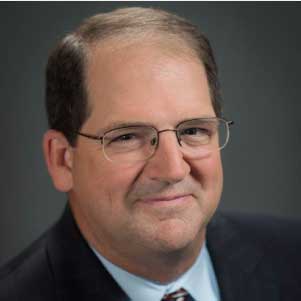
Russell P. Branzell is the CEO and President of the College of Healthcare Information Management Executives (CHIME) and its affiliate associations, the Association for Executives in Healthcare Information Security (AEHIS), the Association for Executives in Healthcare Information Technology (AEHIT) and the Association for Executives in Healthcare Information Applications (AEHIA). In addition to his position at CHIME, he serves on the faculty at Columbia University, where he teaches executive classes in health information technology. He also is a member of the Baldrige Foundation Board and a former member of the Board of Overseers of the Malcolm Baldrige National Quality Award, a position that was appointed by the Secretary of Commerce.
Mr. Branzell joined CHIME as President and CEO in April 2013 after being an active member for 15 years. He served on the CHIME Board of Trustees from 2004-2008, as chair of the CHIME Education Committee from 2004-2008 and as chair of the CHIME Education Foundation. He is currently a faculty member of the CHIME Healthcare CIO Boot Camp.
Prior to taking his position at CHIME, he was the CEO at the Colorado Health Medical Group; Vice President of Information Services and CIO for Poudre Valley Health System; President/CEO of Innovation Enterprises (PVHS’ for-profit IS entity); and Regional Deputy CIO and Executive Director of Information Services for Sisters of Mercy Health System in St. Louis, MO. He served on active duty in the United States Air Force and retired from the Air Force Reserves in 2008. While on active duty, he held numerous healthcare administration positions, including CIO for the Air Mobility Command Surgeon General’s Office.
A native of San Antonio, Mr. Branzell earned an undergraduate degree in business administration, specializing in human resource management and labor relations from the University of Texas. In addition, he earned a master’s degree in Aerospace Science from Embry-Riddle University with an emphasis in management.
Recent Episodes
About the host
Paddy is the co-author of Healthcare Digital Transformation – How Consumerism, Technology and Pandemic are Accelerating the Future (Taylor & Francis, Aug 2020), along with Edward W. Marx. Paddy is also the author of the best-selling book The Big Unlock – Harnessing Data and Growing Digital Health Businesses in a Value-based Care Era (Archway Publishing, 2017). He is the host of the highly subscribed The Big Unlock podcast on digital transformation in healthcare featuring C-level executives from the healthcare and technology sectors. He is widely published and has a by-lined column in CIO Magazine and other respected industry publications.
Connect

